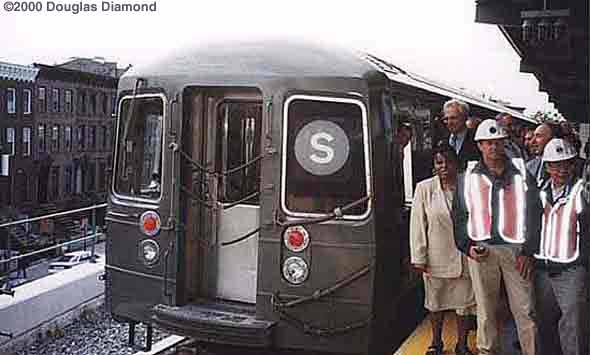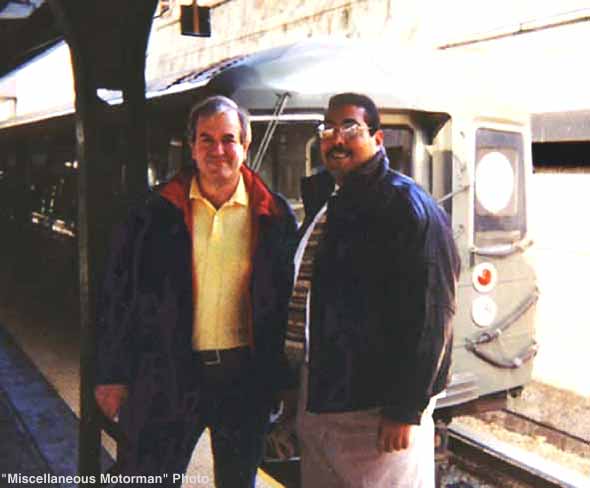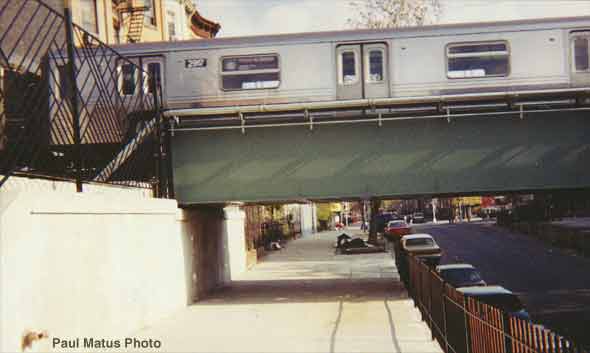
![]()
Page 5

At the opening
ceremonies, part of the Franklin Shuttle rehabilitation team
poses beside the R-68 after the inaugural run. Douglas Diamond
photo
Conclusion
To be fair, the positive aspects of the
reconstructed line outweigh the negatives. On the positive side there is
the re-built roadbed, without which no trains could run at all. The entire
elevated structure was in danger of collapse and required serious repairs
or otherwise faced abandonment. And, of course the connection with the IRT
lines at Botanic Garden station is most beneficial as it allows for
passengers to move between BMT, IRT and IND systems should any one of
those lines faces service
delays.
My only criticism in
regards to the new Franklin Shuttle is that it appears not to have been
reconstructed with the thought of using it to make emergency connections
in the event of delays on any of the connecting subway lines. The fact
that the rebuilt stations can only handle trains of two 75-foot cars—plus
the one-track operation north of Botanic Garden station—means the Franklin
will be ill equipped to manage the extra passenger loads should rush-hour
riders from the Brighton Line attempt to reach the IND 8th Ave. Line (A/C)
or vice-versa.
The real triumph
of the new Franklin Shuttle is the way in which elected officials,
community leaders and public and private corporate interests united to
reach a common goal. The myth that such diverse groups have to be at
constant odds is shattered by a project such as the Franklin Shuttle. It
should be a reminder of what can be achieved when spirit,
drive and commitment are combined with planning and
vision.
Though only is little more
than a mile in length, there is something distinctly "Brooklyn" about the
Franklin Shuttle. Maybe because it is an underdog in the realm of urban
transportation—much like the old Brooklyn Dodgers who (once located at
Ebbets Field along the Shuttle's route) had to fight for their place in
the sun—the line struggles against the odds to prove it can stand the test
of time.
The Franklin Shuttle
may have been brought into the 21st Century, but it is still a humbling
thought that though we are in the computer age, urban transportation is
still primarily dependant on steel wheels riding on steel rails.
©2000 Douglas Diamond
|
5 |

At
the Shuttle platform at Prospect Park, the author (Doug Diamond, right) poses with
editor Paul Matus as one of the Shuttle's trainsets waits behind.
Miscellaneous Motorman photo

Into
the 22nd Century? The old structure had originally been intended
for lighter elevated cars. The structure was reinforced in 1924 for subway
cars but, by the 1990s, the old steelwork succumbed to years of pounding
and years of studied neglect. The new bridge over Park Place looks ready
to handle whatever use the Shuttle might need in an optimistic future.
Paul Matus photo
The Third Rail and The Third Rail logo are trademarks of The Composing Stack Inc.
Return to The Third Rail Online Home
Return to
rapidtransit.net Home
Everything on this site is copyright © 2000 by The Composing
Stack Inc., except as otherwise noted.
Materials
with other copyrights are used by permission.
All
rights reserved
Last updated March 3, 2000